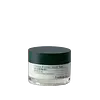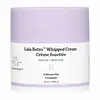What's inside
What's inside
 Key Ingredients
Key Ingredients

 Benefits
Benefits

 Concerns
Concerns

 Ingredients Side-by-side
Ingredients Side-by-side

Water
Skin ConditioningPropanediol
SolventSqualane
EmollientCetearyl Alcohol
EmollientPanthenol
Skin ConditioningGlycerin
HumectantBetaine
HumectantTrehalose
HumectantPolyglyceryl-2 Stearate
EmulsifyingGlyceryl Stearate
EmollientAmmonium Acryloyldimethyltaurate/Beheneth-25 Methacrylate Crosspolymer
Emulsion StabilisingCetearyl Glucoside
EmulsifyingButylene Glycol
HumectantStearyl Alcohol
EmollientSodium Polyacryloyldimethyl Taurate
Emulsion StabilisingCaprylyl Glycol
EmollientSorbitan Olivate
EmulsifyingStearic Acid
CleansingHydroxyacetophenone
AntioxidantPentylene Glycol
Skin ConditioningHydrogenated Polydecene
EmollientButyrospermum Parkii Butter
Skin ConditioningHelianthus Annuus Seed Oil
EmollientPalmitic Acid
EmollientDipropylene Glycol
HumectantEthylhexylglycerin
Skin ConditioningTrideceth-10
CleansingDisodium EDTA
1,2-Hexanediol
Skin ConditioningPolyglyceryl-10 Myristate
Skin ConditioningArachidic Acid
CleansingSodium Hyaluronate
HumectantTocopherol
AntioxidantMyristic Acid
CleansingOleic Acid
EmollientCetyl Ethylhexanoate
EmollientEthylhexyl Palmitate
EmollientCaprylic/Capric Triglyceride
MaskingAcetyl Hexapeptide-8
HumectantCentella Asiatica Extract
CleansingLonicera Japonica Flower Extract
Skin ConditioningHydroxypropyltrimonium Hyaluronate
Hydrolyzed Hyaluronic Acid
HumectantCamellia Japonica Flower Extract
EmollientSalvia Officinalis Leaf Extract
CleansingMelaleuca Alternifolia Leaf Extract
PerfumingSodium Hyaluronate Crosspolymer
HumectantPalmitoyl Tripeptide-5
Skin ConditioningSodium Acetylated Hyaluronate
HumectantWater, Propanediol, Squalane, Cetearyl Alcohol, Panthenol, Glycerin, Betaine, Trehalose, Polyglyceryl-2 Stearate, Glyceryl Stearate, Ammonium Acryloyldimethyltaurate/Beheneth-25 Methacrylate Crosspolymer, Cetearyl Glucoside, Butylene Glycol, Stearyl Alcohol, Sodium Polyacryloyldimethyl Taurate, Caprylyl Glycol, Sorbitan Olivate, Stearic Acid, Hydroxyacetophenone, Pentylene Glycol, Hydrogenated Polydecene, Butyrospermum Parkii Butter, Helianthus Annuus Seed Oil, Palmitic Acid, Dipropylene Glycol, Ethylhexylglycerin, Trideceth-10, Disodium EDTA, 1,2-Hexanediol, Polyglyceryl-10 Myristate, Arachidic Acid, Sodium Hyaluronate, Tocopherol, Myristic Acid, Oleic Acid, Cetyl Ethylhexanoate, Ethylhexyl Palmitate, Caprylic/Capric Triglyceride, Acetyl Hexapeptide-8, Centella Asiatica Extract, Lonicera Japonica Flower Extract, Hydroxypropyltrimonium Hyaluronate, Hydrolyzed Hyaluronic Acid, Camellia Japonica Flower Extract, Salvia Officinalis Leaf Extract, Melaleuca Alternifolia Leaf Extract, Sodium Hyaluronate Crosspolymer, Palmitoyl Tripeptide-5, Sodium Acetylated Hyaluronate
Water
Skin ConditioningGlycerin
HumectantCaprylic/Capric Triglyceride
MaskingIsopropyl Isostearate
EmollientPseudozyma Epicola/Camellia Sinensis Seed Oil Ferment Extract Filtrate
HumectantGlyceryl Stearate Se
EmulsifyingCetearyl Alcohol
EmollientPalmitic Acid
EmollientStearic Acid
CleansingPentylene Glycol
Skin ConditioningPlantago Lanceolata Leaf Extract
AntimicrobialAdansonia Digitata Seed Oil
EmollientCitrullus Lanatus Seed Oil
EmollientPassiflora Edulis Seed Oil
EmollientSchinziophyton Rautanenii Kernel Oil
EmollientSclerocarya Birrea Seed Oil
HumectantXimenia Americana Seed Oil
EmollientCholesterol
EmollientCeramide AP
Skin ConditioningCeramide EOP
Skin ConditioningSodium Hyaluronate Crosspolymer
HumectantCeramide NP
Skin ConditioningPhytosphingosine
Skin ConditioningCeteareth-20
CleansingTrisodium Ethylenediamine Disuccinate
Tocopherol
AntioxidantSodium Lauroyl Lactylate
EmulsifyingSodium Hydroxide
BufferingCitric Acid
BufferingCarbomer
Emulsion StabilisingXanthan Gum
EmulsifyingCaprylyl Glycol
EmollientSodium Chloride
MaskingSodium Carbonate
BufferingChlorphenesin
AntimicrobialPhenoxyethanol
PreservativeEthylhexylglycerin
Skin ConditioningWater, Glycerin, Caprylic/Capric Triglyceride, Isopropyl Isostearate, Pseudozyma Epicola/Camellia Sinensis Seed Oil Ferment Extract Filtrate, Glyceryl Stearate Se, Cetearyl Alcohol, Palmitic Acid, Stearic Acid, Pentylene Glycol, Plantago Lanceolata Leaf Extract, Adansonia Digitata Seed Oil, Citrullus Lanatus Seed Oil, Passiflora Edulis Seed Oil, Schinziophyton Rautanenii Kernel Oil, Sclerocarya Birrea Seed Oil, Ximenia Americana Seed Oil, Cholesterol, Ceramide AP, Ceramide EOP, Sodium Hyaluronate Crosspolymer, Ceramide NP, Phytosphingosine, Ceteareth-20, Trisodium Ethylenediamine Disuccinate, Tocopherol, Sodium Lauroyl Lactylate, Sodium Hydroxide, Citric Acid, Carbomer, Xanthan Gum, Caprylyl Glycol, Sodium Chloride, Sodium Carbonate, Chlorphenesin, Phenoxyethanol, Ethylhexylglycerin
 Reviews
Reviews

Ingredients Explained
These ingredients are found in both products.
Ingredients higher up in an ingredient list are typically present in a larger amount.
This ingredient is an emollient, solvent, and texture enhancer. It is considered a skin-softener by helping the skin prevent moisture loss.
It helps thicken a product's formula and makes it easier to spread by dissolving clumping compounds.
Caprylic Triglyceride is made by combining glycerin with coconut oil, forming a clear liquid.
While there is an assumption Caprylic Triglyceride can clog pores due to it being derived from coconut oil, there is no research supporting this.
Learn more about Caprylic/Capric TriglycerideCaprylyl Glycol is a humectant and emollient, meaning it attracts and preserves moisture.
It is a common ingredient in many products, especially those designed to hydrate skin. The primary benefits are retaining moisture, skin softening, and promoting a healthy skin barrier.
Though Caprylyl Glycol is an alcohol derived from fatty acids, it is not the kind that can dry out skin.
This ingredient is also used as a preservative to extend the life of products. It has slight antimicrobial properties.
Learn more about Caprylyl GlycolCetearyl alcohol is a mixture of two fatty alcohols: cetyl alcohol and stearyl alcohol. It is mainly used as an emulsifier. Emulsifiers help prevent the separation of oils and products. Due to its composition, it can also be used to thicken a product or help create foam.
Cetearyl alcohol is an emollient. Emollients help soothe and hydrate the skin by trapping moisture.
Studies show Cetearyl alcohol is non-toxic and non-irritating. The FDA allows products labeled "alcohol-free" to have fatty alcohols.
This ingredient is usually derived from plant oils such as palm, vegetable, or coconut oils. There is debate on whether this ingredient will cause acne.
Due to the fatty acid base, this ingredient may not be Malassezia folliculitis safe.
Learn more about Cetearyl AlcoholEthylhexylglycerin (we can't pronounce this either) is commonly used as a preservative and skin softener. It is derived from glyceryl.
You might see Ethylhexylglycerin often paired with other preservatives such as phenoxyethanol. Ethylhexylglycerin has been found to increase the effectiveness of these other preservatives.
Glycerin is already naturally found in your skin. It helps moisturize and protect your skin.
A study from 2016 found glycerin to be more effective as a humectant than AHAs and hyaluronic acid.
As a humectant, it helps the skin stay hydrated by pulling moisture to your skin. The low molecular weight of glycerin allows it to pull moisture into the deeper layers of your skin.
Hydrated skin improves your skin barrier; Your skin barrier helps protect against irritants and bacteria.
Glycerin has also been found to have antimicrobial and antiviral properties. Due to these properties, glycerin is often used in wound and burn treatments.
In cosmetics, glycerin is usually derived from plants such as soybean or palm. However, it can also be sourced from animals, such as tallow or animal fat.
This ingredient is organic, colorless, odorless, and non-toxic.
Glycerin is the name for this ingredient in American English. British English uses Glycerol/Glycerine.
Learn more about GlycerinPalmitic Acid is a fatty acid naturally found in our skin and in many plant and animal sources. In cosmetics, it is usually derived from palm oil. It serves many purposes in skincare, acting as a cleanser, emollient, and emulsifier.
As an emollient, palmitic acid helps soften and smooth the skin by preventing water loss. In cleansers, it helps remove oil and dirt while creating foam.
Its emulsifying properties help stabilize products by keeping water and oil-based ingredients from separating.
This may not be suitable for fungal acne-prone skin, as fatty acids like this can sometimes trigger breakouts in sensitive individuals.
Learn more about Palmitic AcidPentylene glycol is typically used within a product to thicken it. It also adds a smooth, soft, and moisturizing feel to the product. It is naturally found in plants such as sugar beets.
The hydrophilic trait of Pentylene Glycol makes it a humectant. As a humectant, Pentylene Glycol helps draw moisture from the air to your skin. This can help keep your skin hydrated.
This property also makes Pentylene Glycol a great texture enhancer. It can also help thicken or stabilize a product.
Pentylene Glycol also acts as a mild preservative and helps to keep a product microbe-free.
Some people may experience mild eye and skin irritation from Pentylene Glycol. We always recommend speaking with a professional about using this ingredient in your routine.
Pentylene Glycol has a low molecular weight and is part of the 1,2-glycol family.
Learn more about Pentylene GlycolSodium Hyaluronate Crosspolymer is a type of hyaluronic acid. In fact, it is modified version of hyaluronic acid.
The structure of Sodium Hyaluronate Crosspolymer allows it to stay in the skin's top layer for a longer period of time. This allows for even more hydration and humectant action than hyaluronic acid.
These are some other common types of Hyaluronic Acid:
Learn more about Sodium Hyaluronate CrosspolymerStearic Acid is a fatty acid. It is an emollient, emulsifier, and texture enhancer.
As an emollient, stearic acid helps soften skin. It aids the skin's protective barrier by preventing water loss. It also provides a gentle cleansing effect without stripping away natural oils.
Stearic acid may also be used to enhance the texture of products. It can add volume and stabilize ingredients such as water and oil. This can help water and oil ingredients from separating.
Sources of stearic acid include animal or vegetable fats/oils such as coconut or shea. It can be naturally found in butter, cocoa butter, shea butter, vegetable fats, and animal tallow.
This ingredient may not be Malassezia folliculitis, or fungal-acne safe.
Learn more about Stearic AcidTocopherol (also known as Vitamin E) is a common antioxidant used to help protect the skin from free-radicals and strengthen the skin barrier. It's also fat soluble - this means our skin is great at absorbing it.
Vitamin E also helps keep your natural skin lipids healthy. Your lipid skin barrier naturally consists of lipids, ceramides, and fatty acids. Vitamin E offers extra protection for your skin’s lipid barrier, keeping your skin healthy and nourished.
Another benefit is a bit of UV protection. Vitamin E helps reduce the damage caused by UVB rays. (It should not replace your sunscreen). Combining it with Vitamin C can decrease sunburned cells and hyperpigmentation after UV exposure.
You might have noticed Vitamin E + C often paired together. This is because it is great at stabilizing Vitamin C. Using the two together helps increase the effectiveness of both ingredients.
There are often claims that Vitamin E can reduce/prevent scarring, but these claims haven't been confirmed by scientific research.
Learn more about TocopherolWater. It's the most common cosmetic ingredient of all. You'll usually see it at the top of ingredient lists, meaning that it makes up the largest part of the product.
So why is it so popular? Water most often acts as a solvent - this means that it helps dissolve other ingredients into the formulation.
You'll also recognize water as that liquid we all need to stay alive. If you see this, drink a glass of water. Stay hydrated!
Learn more about Water